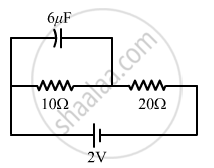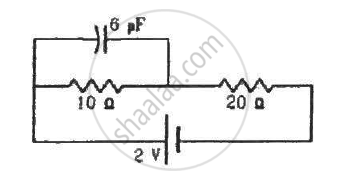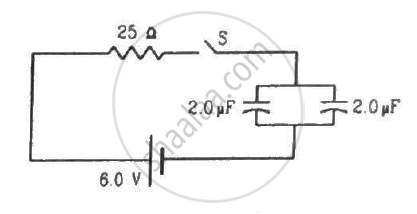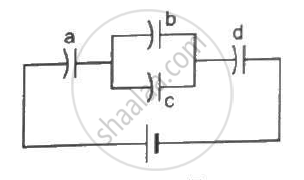Advertisements
Advertisements
Question
A capacitor of capacitance 500 μF is connected to a battery through a 10 kΩ resistor. The charge stored in the capacitor in the first 5 s is larger than the charge stored in the next.
(a) 5 s
(b) 50 s
(c) 500 s
(d) 500 s
Solution
(a) 5 s
(b) 50 s
(c) 500 s
(d) 500 s
The charge (Q) on the capacitor at any instant t,
\[Q = CV(1 - e^{- t/RC} )\]
where
C = capacitance of the given capacitance
R = resistance of the resistor connected in series with the capacitor
RC = (10 × 103) × (500 × 10-6) = 5 s
The charge on the capacitor in the first 5 seconds,
\[Q_0 = CV(1 - e^{- 5/5} ) = CV \times 0 . 632 \]
The charge on the capacitor in the first 10 seconds,
\[Q_1 = CV(1 - e^{- 10/5} )\]
\[ Q_1 = CV(1 - e^{- 2} ) = 0 . 864 \times CV\]
Charge developed in the next 5 seconds,
Q' = Q1 - Q0
Q' = CV(0.864 - 0.632) = 0.232 CV
The charge on the capacitor in the first 55 seconds,
\[Q_2 = CV(1 - e^{- 55/5} )\]
\[ Q_2 = CV(1 - e^{- 11} ) = 0 . 99 \times CV\]
Charge developed in the next 50 seconds,
Q' = Q2 - Q0
Q' = CV(0.99 - 0.632) = 0.358 CV
Charge developed in the first 505 seconds,
\[Q_3 = CV(1 - e^{- 500/5} ) = CV(1 - e^{- 100} ) \approx CV\]
Charge developed in the next 500 seconds,
Q' = CV (1 - 0.632) = 0.368 CV
Thus, the charge developed on the capacitor in the first 5 seconds is greater than the charge developed in the next 5,50, 500 seconds.
Notes
Out of the four given options, two options are same.
APPEARS IN
RELATED QUESTIONS
Find the charge on the capacitor as shown in the circuit.

Find the charge on the capacitor shown in the figure.

The plates of a capacitor of capacitance 10 μF, charged to 60 μC, are joined together by a wire of resistance 10 Ω at t = 0. Find the charge on the capacitor in the circuit at (a) t = 0 (b) t = 30 μs (c) t = 120 μs and (d) t = 1.0 ms.
How many time constants will elapse before the energy stored in the capacitor reaches half of its equilibrium value in a charging RC circuit?
A capacitor of capacitance 12.0 μF is connected to a battery of emf 6.00 V and internal resistance 1.00 Ω through resistanceless leads. 12.0 μs after the connections are made, what will be (a) the current in the circuit (b) the power delivered by the battery (c) the power dissipated in heat and (d) the rate at which the energy stored in the capacitor is increasing?
A capacitance C charged to a potential difference V is discharged by connecting its plates through a resistance R. Find the heat dissipated in one time constant after the connections are made. Do this by calculating ∫ i2R dt and also by finding the decrease in the energy stored in the capacitor.
By evaluating ∫i2Rdt, show that when a capacitor is charged by connecting it to a battery through a resistor, the energy dissipated as heat equals the energy stored in the capacitor.
Find the charge on each of the capacitors 0.20 ms after the switch S is closed in the figure.

Each capacitor in figure has a capacitance of 10 µF. The emf of the battery is 100 V. Find the energy stored in each of the four capacitors.

A capacitor of capacitance 100 μF is connected across a battery of emf 6 V through a resistance of 20 kΩ for 4 s. The battery is then replaced by a thick wire. What will be the charge on the capacitor 4 s after the battery is disconnected?
A point charge Q is placed at the origin. Find the electrostatic energy stored outside the sphere of radius R centred at the origin.
Choose the correct option:
Energy stored in a capacitor and dissipated during charging a capacitor bear a ratio.
If the p. d. across a capacitor is increased from 10 V to 30 V, then the energy stored with the capacitor ____________.
A parallel plate condenser is immersed in an oil of dielectric constant 2. The field between the plates is ______.
An air-filled parallel plate capacitor has a uniform electric field `overset(->)("E")` in the space between the plates. If the distance between the plates is 'd' and the area of each plate is 'A', the energy stored in the capacitor is ______
(∈0 = permittivity of free space)
A parallel plate capacitor has a uniform electric field ‘`vec "E"`’ in the space between the plates. If the distance between the plates is ‘d’ and the area of each plate is ‘A’, the energy stored in the capacitor is ______
(ε0 = permittivity of free space)
Do free electrons travel to region of higher potential or lower potential?
Prove that, if an insulated, uncharged conductor is placed near a charged conductor and no other conductors are present, the uncharged body must be intermediate in potential between that of the charged body and that of infinity.
Electrostatic energy of 4 x 10−4 J is stored in a charged 25 pF capacitor. Find the charge on the capacitor.
